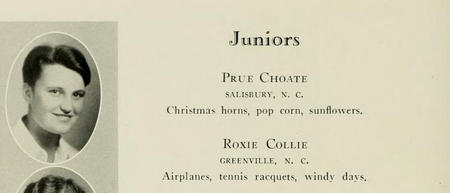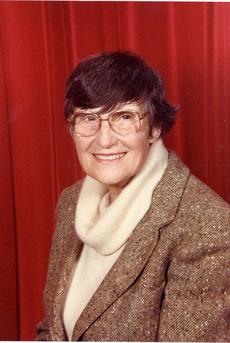
In 1931, Roxie Collie listed airplanes, tennis racquets, and windy days as interests under her name in her yearbook from Meredith College in Raleigh, N.C. The eldest in a family of 15 children, her hobbies included the outdoors, animals, engines, and model airplanes, which were considered improper for a female during that time. In college she had the opportunity to play basketball and participate in track, as well as being the first to wear blue jeans at the all-girls college. She also enjoyed mowing the college’s courtyard in her coveralls. She received her B.A. from Meredith in 1932, and her M.S. in plant ecology from the George Washington University in 1951.
 That pioneering spirit led Roxie Collie Laybourne to go on to create the important field of forensic ornithology, which identifies dead birds from feather samples or fragments which can be quite small. Some aircraft accidents have been caused by bird strikes (collision between birds and aircraft) and forensic ornithology has improved safety through the use of bird data, by making modifications to flight plans and creating programs to scare away birds at some airports.
That pioneering spirit led Roxie Collie Laybourne to go on to create the important field of forensic ornithology, which identifies dead birds from feather samples or fragments which can be quite small. Some aircraft accidents have been caused by bird strikes (collision between birds and aircraft) and forensic ornithology has improved safety through the use of bird data, by making modifications to flight plans and creating programs to scare away birds at some airports.
Laybourne worked on aircraft engines during college and took an aeronautics correspondence course, after not being able to attend aviation school because she was female. She even got into trouble with her college after going to the airport to see Amelia Earhart. After graduating she worked at the National Fisheries Laboratory in Beaufort, N.C., and the North Carolina State Museum before coming to the Smithsonian in 1944 in the Division of Birds as a museum aide for a short-term position. Nevertheless, she stayed on at the Smithsonian with the U.S. Fish and Wildlife Service Bird and Mammal Laboratory, and founded the forensic ornithology program in the 1960s.
Her method was to identify species of birds from feathers by using light and scanning electron microscopy, in conjunction with studying the substructure of the wings. The feather identification program came about after Laybourne assisted in the investigation of a fatal crash at Logan Airport in Boston in 1960 and starlings were determined to be the cause. Laybourne then started using the Smithsonian’s collection of preserved bird specimens for feather study to identify species that were involved in bird strikes.
Her techniques and tools are still used today and even have aided criminal investigations. One case Laybourne assisted with was a homicide involving a woman who shot her husband in his sleep and some of the feathers from the pillow went in with the bullet. Her work also aided various agencies, including the Federal Aviation Administration, the National Transportation Safety Board, the FBI, and the U.S. military.
 Known as the “Feather Lady, ” she also taught bird-skinning courses to many budding ornithologists.
Known as the “Feather Lady, ” she also taught bird-skinning courses to many budding ornithologists.
In a 2001 oral history interview with Smithsonian Historian Pamela Henson, Laybourne talked about mental challenges of the work and said it was not meant for everyone. She considered the field to still be developing. Laybourne retired in 1988 but still performed feather identifications as a Smithsonian Research Associate until her death in 2003 at age 92. The Feather Identification Lab at the Smithsonian continues this important work.
Audio clips from Roxie C. S. Laybourne Interviews, 2001, Smithsonian Institution Archives, Record Unit 9610.
Roxie Laybourne talking about the importance of sharing knowledge.
Roxie Laybourne talking about her approach to life.
Roxie Laybourne talking about working at the Smithsonian Institution.
Related Collections
- Record Unit 9610Roxie C. S. Laybourne Interviews, 2001, Smithsonian Institution Archives
- Accession 04-086, National Museum of Natural History, Division of Birds, Curatorial Records, 1972-2000, Smithsonian Institution Archives
Related Resources
Produced by the Smithsonian Institution Archives. For copyright questions, please see the Terms of Use.

Leave a Comment